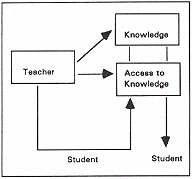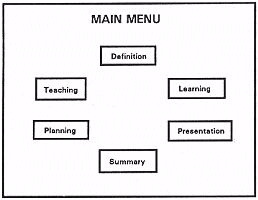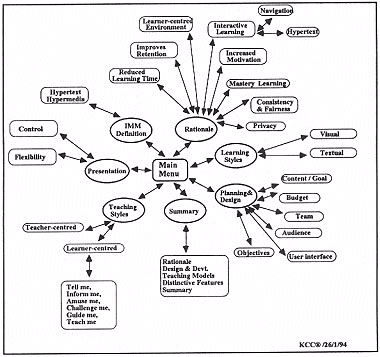
 |
As the world hurtles towards the 21st Century, it is necessary that educators should pause to evaluate the development of new technologies like interactive multimedia and understand its impact on education. This paper will discuss the rationale for interactive multimedia use and examine its ability to enhance instruction, learning and presentations through interactive, hypertexting and linkage techniques Through this innovative approach, users are stimulated via their multisensory modalities to better focus on and retain the messages sent to them. Learners benefit from multimedia because they can now enjoy learning intuitively, independently or socially. Proper integration and use of interactive multimedia in education can help smooth the path to instructional enlightenment because it can, among other things, provide effective communication, clarify, concepts and enhance teaching and learning via the natural multisensory and intuitive approach. Therefore, our task as instructors and trainers, is to sort, absorb, understand and utilise these new technologies to optimise teaching, training and learning.
Since the 1960s, the use of CBT, CMI, CAI and CAL were established norms for training in industry, medicine, the military and for. instruction in education. Although they have shown great promise, they've been rather disappointing as they tend to be largely verbal, textual and linear in structure and still employ limited sequential 'page turning' techniques. Also, the older CBT, CMI, CAL packages lost impact simply because they were not tailored to meet the needs of the users.
Nevertheless, some CAI programs tried 'marrying' Artificial Intelligence with computer assisted instruction which resulted in ICAI or 'Intelligent CAI' (Wyer, 1987). This was the predecessor of attempts to "approach the learning situation from a less controlled, less technology driven and more student driven perspective" (Sleeman & Brown, 1981). Attempts by Colby to develop a program which attempted to simulate the exchange between a psychotherapist and a patient proved to be rather 'primitive'. Authoring of such ICAI was very complex and the constraint of limited computing power at that time made such projects problematic.
Thus, the multimedia revolution of the 1990s is not entirely new. The computer theorist, Dough Engelbart, initially expressed the idea in the 1960s and the concept was later refined by Ted Nelson in his book Computer Lib. It was Nelson who coined the terms hypertext and hypermedia to refer to "non-sequential documents" made up of text, audio, and visual information. This concept of accessing different levels of information of the various formats (text, graphics, audio, animation) grew with the increasing power of computers.
The 90s is an age where the learner environment is more learner oriented when compared with the teacher oriented emphasis of the past. The following is a summary of some advantages that can be gained by utilising multimedia in the modem smart classroom:

Figure 1: Traditional role of the teacher (N. Paine)
With this change in role, the teacher becomes a true facilitator, a manager of the learning process rather than the source of all knowledge. The teacher still remains in control but steps to one side to allow the student a more direct access to knowledge (as shown in Fig. 2), with the teacher facilitating and organising the learning process.

Figure 2: Desirable new teaching model (N. Paine)
This can be achieved because the state of the art of interactive multimedia has opened up new possibilities of knowledge engineering and knowledge linkage. The layers of information can be made intuitively available to the learners, without the learners having to understand the complexity of knowledge engineering and linkages that went behind its creation.
The learner is given more control over what and how he/she wants to learn. This transmission of information is done via the different modalities like sight, sound and touch, that is it allows learning through the most natural means - the senses. The more user friendly and intuitive an interactive multimedia program becomes, the more likely the learners will become motivated and benefit from the interactive learning experience. A recent study on the effectiveness of multimedia use in teacher training conducted on sixty-six trainee teachers by Lou C. T. of the National Institute of Education, Singapore, revealed that there is significant gain in learning for trainee teachers after using the prototype multimedia program. The post-test scores based. on a 20-item questionnaire, registered a positive average gain of 1.09 points over the pre-test scores.
Interactive multimedia has helped learners break away from perceiving information in a linear or 'page turning' fashion. Hypermedia allows users to combine, edit and orchestrate a database of sound, graphics, moving pictures, text and computer software, at the click of a mouse. In addition, hypermedia lets a learner choose from a variety of suggested paths through databases, and/or forge new paths for themselves by creating new links or oven extend the materials that they are studying.
Interactive multimedia can also be made into a very personal, private, and non-judgmental learning by allowing the learners repeated individual access to information and explanations. Learners decide how much they need to learn about a topic. They are therefore spared the frustration of information overload. The more adventurous and gifted are challenged to insert links, delete and even amend sections. (However, it must be pointed out that for more sophisticated usage like editing or programming, the learners need to become fairly well acquainted with the software and should be conversant with programming practices). Thus the beauty of interactive multimedia lie in the options and control it offers learners. The table below illustrates how such options (not necessarily in such sequential order can be integrated into a well designed multimedia program.
However, there is always the danger of overdoing a multimedia presentation/ program with too much colour, gimmicky animation and transitions so that the learners are dazzled by the medium and forget the message. Therefore, we need to guard against the tendency to over draw and over illustrate in order to ensure the maintenance of graphic consistency and relevant colour use. Also, as presenters and instructors, we have to be cognisant of the fact that some learners may suffer from cyberphobia or fear of computers and this may, in fact, hinder their acquisition of knowledge through the interactive multimedia approach.
| Request | System's Interpretation |
| Tell me | Give me the facts, no embellishments |
| Inform me | Give me the facts plus background and other viewpoints |
| Amuse me | Find interesting connections or perspectives |
| Challenge me | Make me find or create connections or insights |
| Guide me | Suggest pathways but let me browse |
| Teach me | Provide step by step guidance |
For such learners more training and familiarisation with computers is necessary before they can comfortably benefit from an interactive multimedia program.
Efficient multimedia presentations provide presenters with greater interactive styles of presentation today. By using hypertexting techniques, like branching and linkage, information can be concept mapped, layered and networked so that access can be, to a large extent, random and speedy. Starting from a main menu as the home base, a presenter can access any nodes or subunits of information which are further linked to other layers and nodes of related information. Thus, a presenter has the option of selecting basic level information or delving deeper for more complex or cross referenced explanations. For example, The Main Menu may consist of five or six icons/buttons like in Figure 3.

Figure 3: Diagram of the Main Menu of a presentation
If you are creating your own multimedia presentation, planning a good screen design to provide for an efficient and friendly user interface is critical. For example, decisions will have to be made regarding the hypertext design that allows for navigation. Hypertexting design can be varied and may be hierarchical in structure, or it can have a simple to complex structure. For example, the concept mapping and linking of information in this simple to complex hypertext design of the Main Menu is illustrated in Figure 4. Different types of links like main menu link, replacement links and command links have to be programmed or scripted into the presentation to allow for navigation of the database. These commands can be built under the screen buttons and graphics which then become navigation hot spots. Activating these hot spots by touch screen, mouse or keyboard will bring forth new windows on the screen, return users to main menu and so on.

Figure 4: Chart showing concept mapping of a presentation
The integrative and interactive qualities of multimedia technology make it possible to extend the power of a presentation. Hooked up with a liquid crystal display panel and an overhead projector or with a video projector, a presenter has the ability to project on the large screen, his/her multimedia presentation complete with text, sound, animation and video, to explain more graphically, abstract concepts to the audience.
Therefore, before embarking on an interactive multimedia project a potential interactive multimedia designer/developer may need to ask some/all of the following questions pertaining to planning and design.
When designing interactive multimedia programs for any instructional situation there is a need to carefully evaluate the characteristics of the target population who will be using the product. In addition it is essential to know the environment under which the product will be used. All the friendly user interfaces must be built in so that the system can be very transparent and the users can start straight away using them instead of being bogged down from the start up.
At the start of the project, it is crucial for designer to keep in sight always the goal of the project. It would be helpful to a list all the critical things the designer hopes to accomplish. Here it will be better to be realistic than idealistic. Only attempt those that can be achieved, never be afraid to omit or revise the list of things. It is always a good practice to keep the message design simple.
Do not attempt to use interactive multimedia to represent information on every aspect of teaching. Rather, it should only be applied to content material where traditional audio visual media techniques have failed to communicate the complexity or richness of the materials, or give students precise, personal control over audio visual examples that can help them understand more lucidly, the difficult or abstract concepts that are being taught.
Flow charts can help in the visualisation of the levels of linkages and the flow of information in a complex interactive multimedia program.
A designer should consciously build in formative evaluation on different segments of the project. Periodic testing for validity should be applied to small segments of the product as this will alleviate major revision that could prove costly for the whole finished product. While testing pay special attention to the feedback given by both the experienced users as well as novices and consider ways of improving the design of the interactive multimedia product.
In a sense, designing and developing an interactive multimedia system is analogous to a systems engineering activity involving three basic steps: design, development and testing. The design phase will be aided by the knowledge of the audience characteristics as this will facilitate the design of friendly human-computer interfaces. The development phase involves the production of courseware that are based on previously specified pedagogic objectives and the assembly of hardware that will run the courseware. And finally the testing that will ensure that the system actually fulfils its pedagogic requirements.
Simulation has been successfully incorporated in teaching and learning under the auspices of innovative multimedia. The nearer a simulation approaches reality the more effective it is, as a pedagogical tool.
Interactive multimedia simulations can help students overcome the limitations of space, time and structural complexity like simulating writing the strokes of a Chinese character, or explaining a cell or a DNA structure which is too minute to see. Sound simulation can help students understand the physics of sound and if sound is incorporated into a multimedia demonstration of an erupting volcano, the whole learning experience is enhanced. Current experiments with simulations ranging from economic trends to psychological behaviour, rendered in extremely precise real time 'what if' and virtual reality situations, will add new and even more meaningful enhancement to learning, within this decade.
Many advantages can be gained in the utilisation of interactive multimedia in instruction as this approach suits the learner oriented classroom of the nineties. Distinctive elements of interactive multimedia therefore serves to enhance learning through direct access and instant feedback (interactivity), cohesive linkages, knowledge engineering, simulations, reduction of textual and verbal information and increase in elements that appeal to our multiple. modalities. Furthermore, it caters to different learning styles of individuals.
However, it is vital to emphasise that properly designed and used, the potential of interactive multimedia is undeniable. If abused, multimedia could end up like other 'flash in the pan' technologies and will be at best ineffective, and at worst, useless.
Nevertheless, potential designers of interactive multimedia systems need to be realistic about their goals and budget constraints and need to pay heed to good design principles. It is also important to stress that such innovative interactive multimedia usage should only be applied to content material whom traditional audiovisual media techniques have failed to communicate the complexity or richness of the materials in a teaching-learning environment. Thus if potential interactive multimedia developers follow these guidelines, there will be better and more relevant interactive multimedia programs in future.
Baker. P. G. (1989). Multimedia Computer Assisted Learning, London. Kogan Page.
Brand, S. (1987). The Media Lab: Inventing the Future in MIT. New York: Viking.
Engelbart, D. & Hooper, K. (1988). The augmentation system framework. In S. Ambron & K. Hooper (Eds), Interactive multimedia for developers, educators and information providers. Redmond, WA: Microsoft Press.
Floyd, S. (1991). The IBM Multimedia Handbook. Brady Publishing, New York.
Fong, K. H. et al. (1990). Learning benefits of training technologies. Productivity Digest, pp 4-7.
Horton, W. (1990). Designing and writing online documentation: Help files to hypertext. New York: John Wiley and Sons.
Jones, K. (1988). Interactive learning events: A guide for facilitators. Kogan Page Ltd.
Kernp, J. & Smellie, D. (1989). Planning, producing, and using instructional media. New York: Harper Row.
Kommers, Piet (1993). Scenarios for the development of educational hypermedia. Educational and Training Technology International, 234-254.
Lou, C. T. & Khoo C. C. (1991). Teacher, technology and the instructional arsenal. IT Applications in Education, EDUCOMP 91 Proceedings. pp 220-230.
Megarry, J. (1989). Hypertext and compact disc: The challenge of multimedia learning. Educational and Training Technology International, 306-315.
Megarry, J. (1991). 'Europe in the round': Principles and practice of screen design. British Journal of Educational Technology, 19(3), 172-83.
Nelson, T. (1987). Dream machine/computer lib. Reprinted. Redmond, WA: Tempus Book.
Norman, D. (1988). The psychology of everyday things. New York:Basic Books, Inc.
Rabb, Margaret Y. (Ed). (1990). The presentation design book. Ventana Press Inc.
Tucker, R. N. (Ed). (1989). Interactive media: The human issue. Proceedings of the International Conference Interactivity '88, The Hague, Netherlands, 5-7 October, 1988. London: Kogan Page.
| Author: Khoo Cheng Choo, Assistant Director, Centre for Educational Technology, National University of Singapore, Singapore 0511. Tel: 772-2474 Fax: 777 0342 Email: cetkcc@leonis.nus.sg
Please cite as: Khoo C. C. (1994). Interactive multimedia for teaching, learning and presentations. In C. McBeath and R. Atkinson (Eds), Proceedings of the Second International Interactive Multimedia Symposium, 230-236. Perth, Western Australia, 23-28 January. Promaco Conventions. http://www.aset.org.au/confs/iims/1994/km/khoo.html |